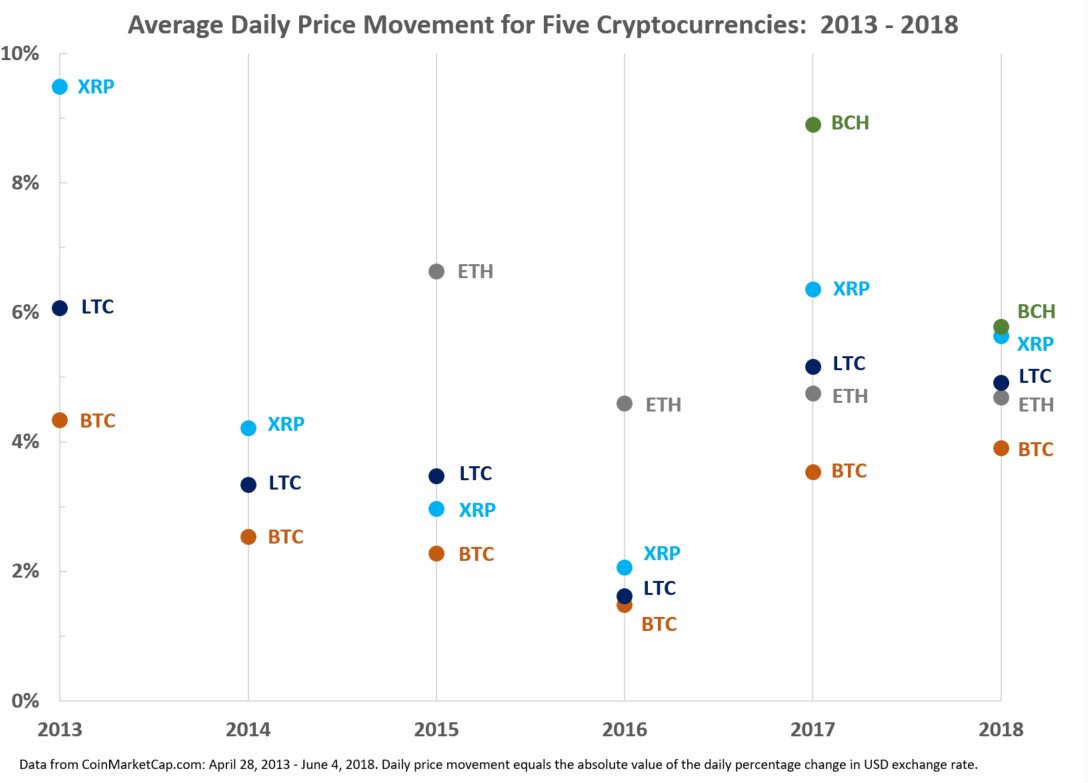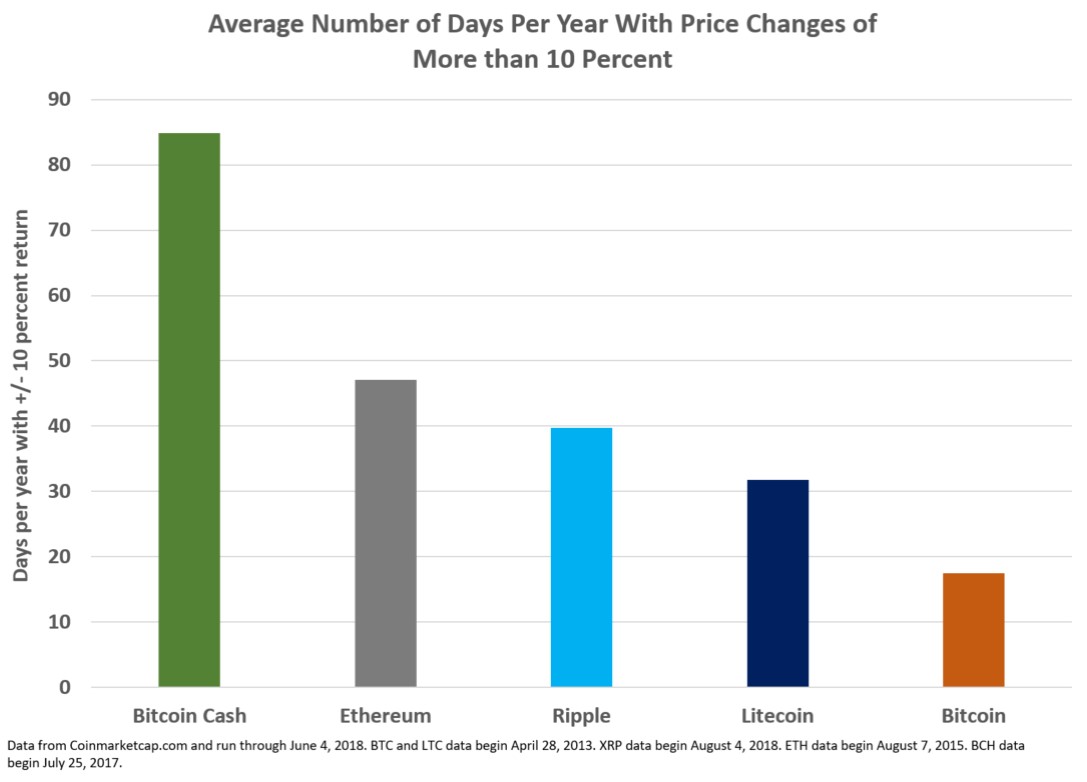Bitcoin Is Less Volatile Than Its Cryptocurrency Cousins
In their brief history, cryptocurrencies have been among the most volatile widely traded assets ever seen. But how do cryptocurrencies compare with each other on simple metrics of volatility? Do some fluctuate in price more than others?
Earlier this year, we compared the volatility of Bitcoin to traditional currencies. We found that the average daily percentage change and standard deviation of Bitcoin’s exchange rate with the U.S. dollar were several times higher than the dollar exchange rate against the euro, yen, pound, and gold.
Now we find that Bitcoin is consistently less volatile than four other widely traded cryptocurrencies: Litecoin, Ripple, Ethereum, and Bitcoin Cash. Looking at simple measures of volatility across digital assets also reveals some common patterns over time and interesting potential trends.
We previously wrote that
the future is unpredictable, which can be a huge deterrent to planning and coordination of plans. A medium of exchange that is stable in value and highly liquid, so someone can trade it in a pinch without taking a hit, allows us to better deal with uncertainty and helps us plan and coordinate into the future. Assets that are too volatile are therefore undesirable as currencies.
While all five cryptocurrencies we study are still quite new, measures of volatility, and changes in those measures over time, are important in assessing their potential future viability as money.
Good Old Dependable Bitcoin?
Economists and statisticians measure a variable’s volatility in many ways. We choose a relatively simple metric: the average daily percentage change in price. We average the absolute value of daily percentage returns for each cryptocurrency and year. (Using the absolute value lets us count positive and negative changes equally. We want changes of +3 percent and −3 percent to average to 3 percent, not zero.)
We analyzed data from CoinMarketCap.com that go back to April 2013 for Bitcoin and Litecoin, and the start date of trading for the other three cryptocurrencies.
The chart below ranks the five cryptocurrencies on average daily price change for each year.
By our measure, in every year, Bitcoin is the least volatile of the five cryptocurrencies we study (we also looked at coefficients of variation, a more technical measure, which yielded similar results). Bitcoin reached its lowest average daily price movement, less than 2 percent, in 2016, before rising again to levels not seen since 2013.
Generally, other cryptocurrencies appear to have started out much more volatile in early years or when they began trading, and converged toward Bitcoin’s level of volatility later in the sample period. For instance, Ripple’s average daily price movement was a full five percentage points higher than Bitcoin’s in 2013, but less than one point higher in 2016. The exception is 2017, when all cryptocurrencies except Ethereum saw significant upticks in average daily price movement.
Interestingly, the first half of 2018 is the closest together the five cryptocurrencies have ever been in average daily price movement. Bitcoin, Litecoin, and Ripple have increased in volatility since low points in 2016, while Ethereum and Bitcoin Cash have decreased.
Big Changes are the Norm
In our earlier work, we reported that average daily price movements for traditional currencies are mere fractions of a percentage point. While cryptocurrencies exhibit larger price changes day-to-day, their higher volatility is really driven by “fat tails,” or the frequent occurrence of days with extremely large price swings.
The chart below shows the number of days on average per year in which each of our five cryptocurrencies had price changes larger than 10 percent.
None of the benchmark assets — euro, yen, pound, or gold — had a single day since 2013 with a change in USD exchange rate greater than 10 percent (the largest single-day change was an 8 percent drop in the pound against the dollar after the Brexit vote).
Contrast this record with Bitcoin Cash, which has averaged well over one day per week with a change greater than 10 percent in its 11-month history.
Once again, Bitcoin comes in lower than the other cryptocurrencies in this measure of volatility, though it still far surpasses traditional currencies.
It’s hard to say with a straight face that Bitcoin is “the stable cryptocurrency,” but compared to its cousins, its wild price swings are a little less wild. This, of course, may change over time, and may be in part a function of the relative newness of Ethereum and Bitcoin Cash. One or more of these cryptocurrencies may be worth a king’s ransom someday, but the phrase “Invest with caution” has never been more apt.
This article is based in part on research by Catherine Udodova and Jack Martin, 2018 graduates of the Berkshire School, as part of the school’s Advanced Math/Science Research program, supervised by Dr. April Burch.














